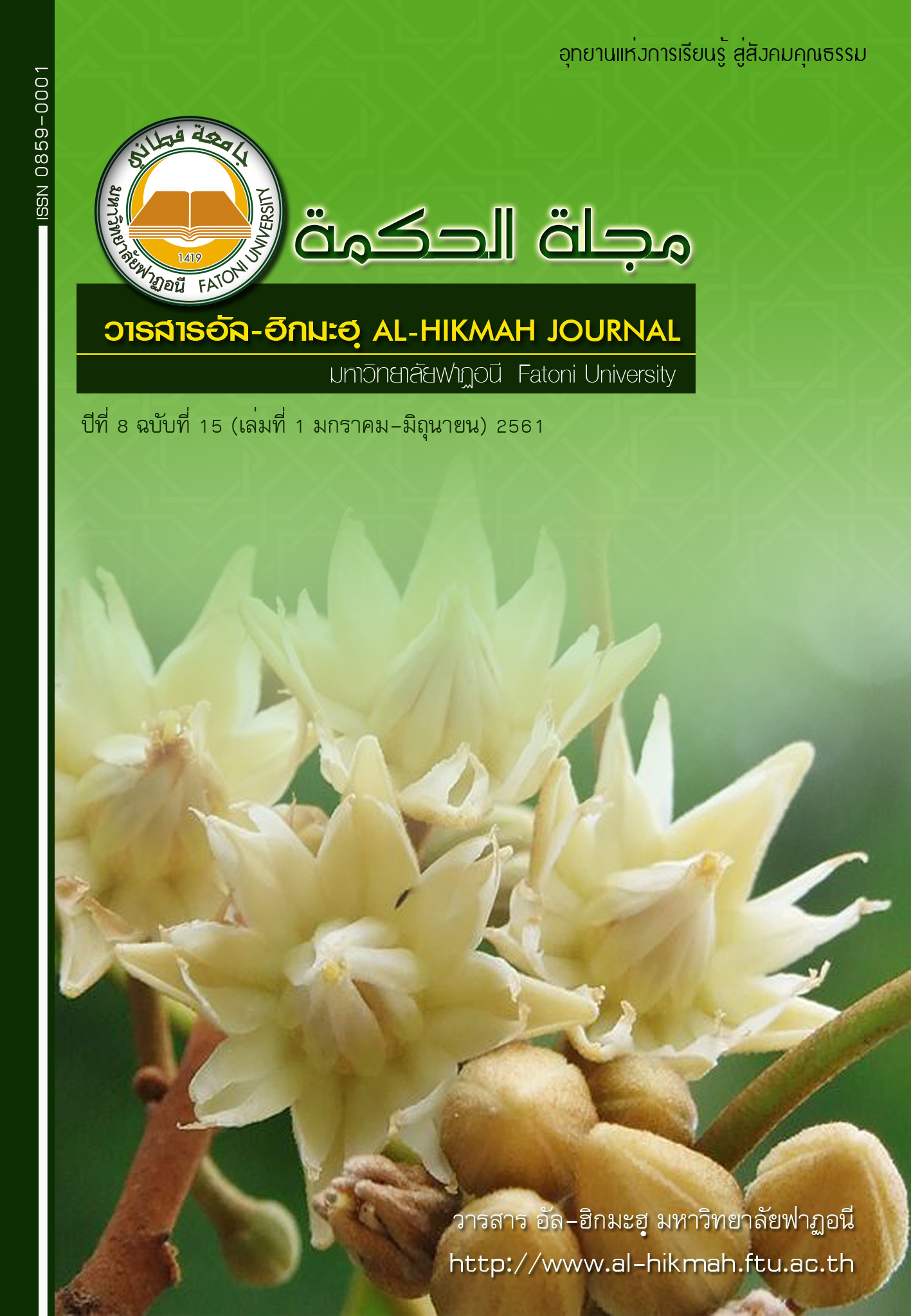การวิจัยเชิงบูรณาการแบบองค์รวมเพื่อพัฒนาทักษะชีวิตของนักเรียนชั้นมัธยมศึกษาตอนปลาย
Abstract
This mixed method research aimed to 1) analyze confirmatory factors of life skills of high school students and investigate the perfect fit with the empirical data, 2) identify life-skill development activities for those students through holistically integrative research, and 3) study the outcomes of the life-skill development activities. Participants of this study were divided into two groups: the first group, designated for quantitative study, were 620 high-school students of The Secondary Educational Service Area 4, Saraburi Province. Instruments for this group were researcher-developed questionnaires. The second group, for qualitative study and the trial group, were 30 students whom purposively determined under the designated condition. The 60-item life skill assessment were used to collect data from this group. For data analysis, the statistic package program was used for analyzing basic statistics, while advanced statistic program was used for Confirmatory Factor Analysis, and content analysis was used to analyzed qualitative data.
Results revealed;
- The second order CFA of high-school students’ life skill were congruent with the empirical data (c2 = 21.60, p = .6587, RMSEA = .00, and other factors met the set-criteria).
- Life-skill development of high school student through the holistically integrative research included eight activities as 1) Natural Music, 2) Crossing the Lines, 3) Reaching the Target, 4) What Do You do, 5) Emotional Flag Race, 6) No Anger, No Fear, 7) Problematic Communication, and 8) Finding Things with Eye Closed.
- The prominence of each life-skill development activity were 1) realization and actualization of self and others; students were happy and had fun, 2) creative decision making and problem solving; students were happy, had fun for being developed, for analyzing, making decision, and solving problem creatively, 3) emotion and stress management; students can show and manage their emotion in the activity including understand others’ emotion and feelings, and 4) making good relationship with others; students value the communication as it can make good relationship with others and good communication makes collaboration within the group.
References
กฤษณา ปัญญา. (2552). การสร้างแบบวัดทักษะชีวิตของนักเรียนในระดับชั้นมัธยมศึกษาปีที่ 6. วิทยานิพนธ์ศึกษาศาสตร์มหาบัณฑิต, สาขาวิชาการวัดและประเมินผลการศึกษา, มหาวิทยาลัยเชียงใหม่.
กาญจนา วัฒายุ. (2548). การวิจัยเพื่อพัฒนาคุณภาพการศึกษา. กรุงเทพฯ: ธนพรการพิมพ์
ชนัดดา เทียนฤกษ์. (2557). การพัฒนาโมเดลการวัดทักษะชีวิตและอาชีพของนักเรียนระดับชั้นมัธยมศึกษาตอนปลายในศตวรรษที่ 21. วิทยานิพนธ์ ค.ม.(วิธีการวิจัยการศึกษา), กรุงเทพฯ: บัณฑิตวิทยาลัย จุฬาลงกรณ์มหาวิทยาลัย. ถ่ายเอกสาร.
ไชยันต์ สกุลประเสริฐ. (2556). การวิเคราะห์องค์ประกอบเชิงยืนยัน. วารสารจิตวิทยาคลินิก. 44(1)
ทิศนา แขมมณี. (2551). รูปแบบการเรียนการสอน : ทางเลือกที่หลากหลาย (พิมพ์ครั้งที่ 5). กรุงเทพฯ : สำนักพิมพ์จุฬาลงกรณ์มหาวิทยาลัย.
นงนภัส คู่วรัญญู เที่ยงกมล. (2554). การวิจัยเชิงบูรณาการแบบองค์รวม (พิมพ์ครั้งที่ 1). กรุงเทพฯ .สำนักพิมพ์แห่งจุฬาลงกรณ์มหาวิทยาลัย.
ปานทอง อังคณิตย์. (2558). การเสริมสร้างทักษะนักเรียน ระดับการศึกษาขั้นพื้นฐาน โดยใช้การวิจัยเชิงปฏิบัติการแบบมีส่วนร่วม. วิทยานิพนธ์ ปร.ด.(การบริหารการศึกษา), บุรีรัมย์: บัณฑิตวิทยาลัย, มหาวิทยาลัยราชภัฎบุรีรัมย์.
ภูริวรรษ คำอ้ายกาวิน. (2557). การนำเสนอกลยุทธ์การจัดการศึกษาเพื่อพัฒนาทักษะชีวิตที่จำเป็นสำหรับเด็กด้อยโอกาสในการเสริมสร้างการยอมรับเป็นสมาชิกของสังคม. วิทยานิพนธ์ ค.ด.(พัฒนศึกษา), กรุงเทพฯ: บัณฑิตวิทยาลัย, จุฬาลงกรณ์มหาวิทยาลัย.
มนลดา กล่อมแก้ว. (2555). การสร้างแบบวัดทักษะชีวิตสำหรับนักเรียนชั้นมัธยมศึกษาตอนปลาย สังกัดสักงานเขตพื้นที่การศึกษามัธยมศึกษา เขต 1 กรุงเทพมหานคร. ปริญญานิพนธ์ กศ.ม. (การวัดผลการศึกษา), กรุงเทพฯ : บัณฑิตวิทยาลัย มหาวิทยาลัยศรีนครินทรวิโรฒ.
รมณภัทร กตตน์วงศกร. (2557). การศึกษาผลการพัฒนาทักษะชีวิตของนักเรียนชั้นประถมศึกษาปีที่ 6 โรงเรียนบางจาก (โกมลประเสริฐอุทิศ) สำนักงานเขตภาษีเจริญ กรุงเทพมหานคร. สารนิพนธ์ กศ.ม.(การบริหารการศึกษา), กรุงเทพฯ: บัณฑิตวิทยาลัย มหาวิทยาลัยศรีนครินทรวิโรฒ. ถ่ายเอกสาร.
วัฒนา ระงับทุกข์. (2542). แผนการสอนที่เน้นผู้เรียนเป็นศูนย์กลาง. กรุงเทพฯ : แอลทีเพรสจำกัด.
วารินท์พร ฟันเฟื่องฟู. (2558). การวิเคราะห์องค์ประกอบเพื่อการพัฒนาทักษะชีวิตของนักเรียนมัธยมศึกษาตอนต้น. วิทยานิพนธ์ ปร.ด.(หลักสูตรและการสอน), มหาวิทยาลัยราชภัฎวไลยอลงกรณ์ ในพระบรมราชูปถัมภ์.
ศักดิ์ชาย สิกขา. 2545. AIC : การจัดประชุมแบบมีส่วนร่วมเพื่อการพัฒนา. อุบลราชธานี : สำนักวิทยบริการ มหาวิทยาลัยอุบลราชธานี.
ศักดิ์นคร สีหอแก้ว. (2557). รูปแบบการสอนเพื่อพัฒนาทักษะชีวิตสำหรับนักเรียนชั้นมัธยมศึกษาในโรงเรียนขยายโอกาสทางการศึกษา. วิทยานิพนธ์ ปร.ด. (การวิจัยและพัฒนาทางการศึกษา), พิษณุโลก: บัณฑิตวิทยาลัย มหาวิทยาลัยนเรศวร.
ศรีเรือน แก้วกังวาน. (2542). จิตวิทยาการชีวิตทุกช่วงวัย. กรุงเทพฯ : โรงพิมพ์มหาวิทยาลัยธรรมศาสตร์.
สิริพัชร์ เจษฎาวิโรจน์. 2546. การจัดการเรียนการสอนแบบบูรณาการ. กรุงเทพฯ: บุ๊ค พอยท์.
สุดาภัทร ประดับแก้ว. (2557). ผลของการจัดโปรแกรมทักษะชีวิตที่มีต่อความสามารถในการจัดการอารมณ์ของนักเรียนชั้นมัธยมศึกษาตอนต้น. วิทยานิพนธ์ ค.ม.(สุขศึกษาและพลศึกษา), กรุงเทพฯ: บัณฑิตวิทยาลัย จุฬาลงกรณ์มหาวิทยาลัย.
อนงค์รัตน์ รินแสงปิน. (2558). การพัฒนากิจกรรมการเรียนรู้แบบมีส่วนร่วมเพื่อเสริมสร้างทักษะชีวิตให้กับแกนนำเด็กและเยาวชนตำบลหลวงใต้. วิทยานิพนธ์ศึกษาศาสตรมหาบัณฑิต สาขาวิชาจิตวิทยาการศึกษาและการแนะแนว, คณะครุศาสตร์ มหาวิทยาลัยราชภัฎลำปาง.
American Psychology Association. (2006). Controlling Anger: Before It Controls You. Retrieved September 26, 2006, from http://www.apa.org/topics/controlanger.html
Bandura, A. (1997). Social Learning Theory. Engle woods Cliffs, N.J.:Prentice -Hall.
Baumeister, Roy F.; Heatherton, Todd F.;& Tice, Dianne M. (1994). Losing Control:
How and WhyPeople Fail at Self-Regulation.New York: Academic Press.
Bender, C. J., & Getruida. (2002). A Life Skills Programmed for Learners in the Senior.
Coon, Dennis. (1997). Essential of Psychology: Exploration and Application. 5th ed. London: West Publishing.
Corey, Gerald. (2005).Theory and Practice of Counseling and Psychotherapy. 7th ed. International Student Edition. California: Thomson Brooks/Cole Inc.
Cronbach, Lee. J. (1990) . Essentials of Psychology Testing. 5th ed. New York : Harper Collins Publishers Inc.
De Jong, T. (1995). Proposed General Guidelines for a Life skills CurriculumFramework. Johannesburg: Centre for Education Policy Development.
Dryden, Windy. (1999). Person-Centered Counseling in Action. London: SAGE Publications.
Eccles, J. S. (1999). The development of children ages 6 to14. The Future of Children When, 2(9), 30-44.
Faupel, Adrian ; Herrick, Elizabeth ;& Sharp, Peter. (1998). Anger Management: A Practical Guide. London: David Fulton Publishers.
Focusing Resource on Effective School Health. (2002). Gates, Ann Q.; et al. (1999). A Cooperative Model for Orienting Students to
Gazda, G. M.; Childers, W. C.; & Brooks, D. K. (1987). Foundations of Counselingand Human Services. New York: McGraw-Hill.
Goleman, D. (1998). Working with emotional intelligence. New York: Bantum Books.
Griffin, K. W., & Botvin, G. J. (2003). Effectiveness of a Universal Drug Abuse Prevention Approach for Youth at High Risk for Substance Use Initiation.
Hair, J. F., et al. (1998). Multivariate Data Analysis. (5thed.). Upper Saddle River, NJ: Prentice Hall.
Jessor, Richard; Donovan, E. J.;& Costa, France M. (1991). BeyondAdolescence Problem Behavior and Young Adult Development. New York:Cambridge University Press.
Kalat, James W. (1999). Introduction to Psychology. New York: Brooks / Cole.
Mangrulkar; L., Whitman, C. V., & Posner, M. (2001). Life skills Approach to Child and Adolescent Health Human Development. Washington, DC: Education Development Center, Inc.
Miller, M. (1998). Self-assessment as a specific strategy for teaching the gifted Learning disabled. Journal for the Education of the Gifted. 178-188.
Rosenbaum, Michael. (1980, January). “A Schedule for Assessing Self-Control Behavior, Preliminary Finding,” Behavior Therapy.11: 109-121.
Schumacker, R. E.: & Lomax R. G. (1996). A beginner’s Guide to Structual Equation Modeling. Mahwah, New Jersey : Lawrence Erlbaum Associates Publishers.



